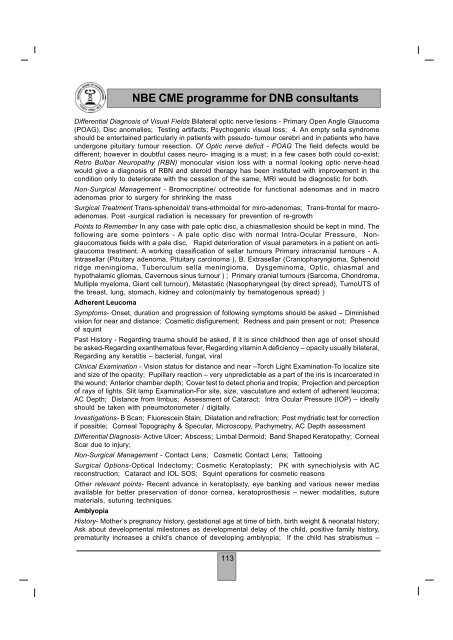NBE CME programme for DNB consultants - National Board Of ...
NBE CME programme for DNB consultants - National Board Of ...
NBE CME programme for DNB consultants - National Board Of ...
Create successful ePaper yourself
Turn your PDF publications into a flip-book with our unique Google optimized e-Paper software.
<strong>NBE</strong> <strong>CME</strong> <strong>programme</strong> <strong>for</strong> <strong>DNB</strong> <strong>consultants</strong>Differential Diagnosis of Visual Fields Bilateral optic nerve lesions - Primary Open Angle Glaucoma(POAG), Disc anomalies; Testing artifacts; Psychogenic visual loss; 4. An empty sella syndromeshould be entertained particularly in patients with pseudo- tumour cerebri and in patients who haveundergone pituitary tumour resection. <strong>Of</strong> Optic nerve deficit - POAG The field defects would bedifferent; however in doubtful cases neuro- imaging is a must; in a few cases both could co-exist;Retro Bulbar Neuropathy (RBN) monocular vision loss with a normal looking optic nerve-headwould give a diagnosis of RBN and steroid therapy has been instituted with improvement in thecondition only to deteriorate with the cessation of the same; MRI would be diagnostic <strong>for</strong> both.Non-Surgical Management - Bromocriptine/ octreotide <strong>for</strong> functional adenomas and in macroadenomas prior to surgery <strong>for</strong> shrinking the massSurgical Treatment Trans-sphenoidal/ trans-ethmoidal <strong>for</strong> miro-adenomas; Trans-frontal <strong>for</strong> macroadenomas.Post -surgical radiation is necessary <strong>for</strong> prevention of re-growthPoints to Remember In any case with pale optic disc, a chiasmallesion should be kept in mind. Thefollowing are some pointers - A pale optic disc with normal Intra-Ocular Pressure, Nonglaucomatousfields with a pale disc, Rapid deterioration of visual parameters in a patient on antiglaucomatreatment. A working classification of sellar turnours Primary intracranial turnours - A.Intrasellar (Pituitary adenoma, Pituitary carcinoma ), B. Extrasellar (Craniopharyngioma, Sphenoidridge meningioma, Tuberculum sella meningioma, Dysgeminoma, Optic, chiasmal andhypothalamic gliomas, Cavernous sinus turnour ) ; Primary cranial turnours (Sarcoma, Chondroma,Multiple myeloma, Giant cell turnour), Metastatic (Nasopharyngeal (by direct spread), TumoUTS ofthe breast, lung, stomach, kidney and colon(mainly by hematogenous spread) )Adherent LeucomaSymptoms- Onset, duration and progression of following symptoms should be asked – Diminishedvision <strong>for</strong> near and distance; Cosmetic disfigurement; Redness and pain present or not; Presenceof squintPast History - Regarding trauma should be asked, if it is since childhood then age of onset shouldbe asked-Regarding exanthematous fever, Regarding vitamin A deficiency – opacity usually bilateral,Regarding any keratitis – bacterial, fungal, viralClinical Examination - Vision status <strong>for</strong> distance and near –Torch Light Examination-To localize siteand size of the opacity; Pupillary reaction – very unpredictable as a part of the iris is incarcerated inthe wound; Anterior chamber depth; Cover test to detect phoria and tropia; Projection and perceptionof rays of lights. Slit lamp Examination-For site, size, vasculature and extent of adherent leucoma;AC Depth; Distance from limbus; Assessment of Cataract; Intra Ocular Pressure (IOP) – ideallyshould be taken with pneumotonometer / digitally.Investigations- B Scan; Fluorescein Stain; Dilatation and refraction; Post mydriatic test <strong>for</strong> correctionif possible; Corneal Topography & Specular, Microscopy, Pachymetry, AC Depth assessmentDifferential Diagnosis- Active Ulcer; Abscess; Limbal Dermoid; Band Shaped Keratopathy; CornealScar due to injury;Non-Surgical Management - Contact Lens; Cosmetic Contact Lens; TattooingSurgical Options-Optical Iridectomy; Cosmetic Keratoplasty; PK with synechiolysis with ACreconstruction; Cataract and IOL SOS; Squint operations <strong>for</strong> cosmetic reasonsOther relevant points- Recent advance in keratoplasty, eye banking and various newer mediasavailable <strong>for</strong> better preservation of donor cornea, keratoprosthesis – newer modalities, suturematerials, suturing techniques.AmblyopiaHistory- Mother’s pregnancy history, gestational age at time of birth, birth weight & neonatal history;Ask about developmental milestones as developmental delay of the child, positive family history,prematurity increases a child’s chance of developing amblyopia; If the child has strabismus –113
















